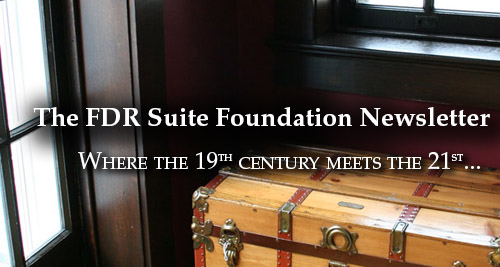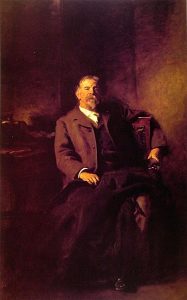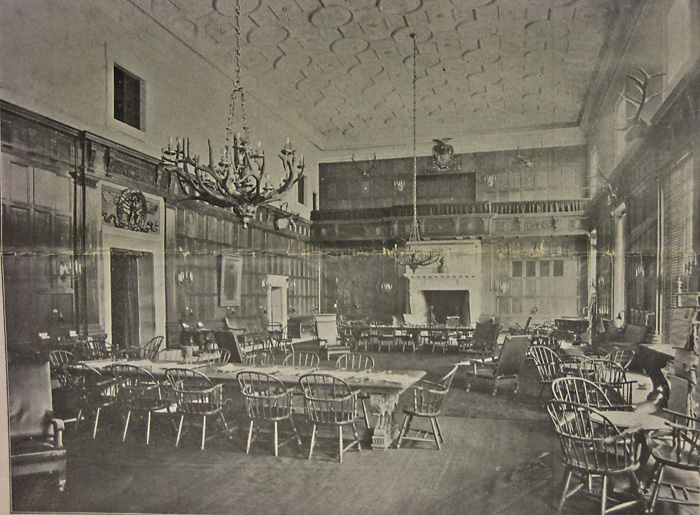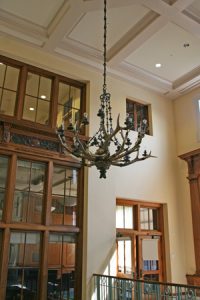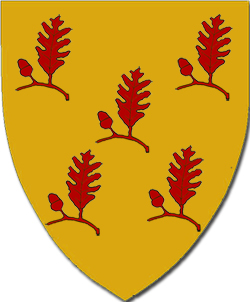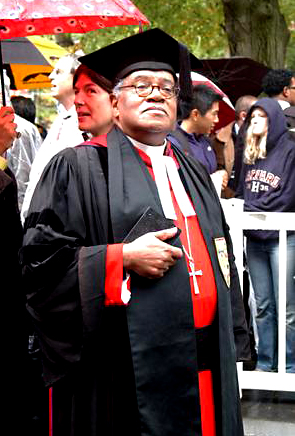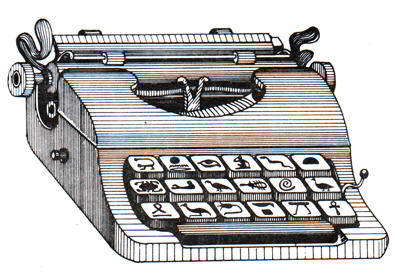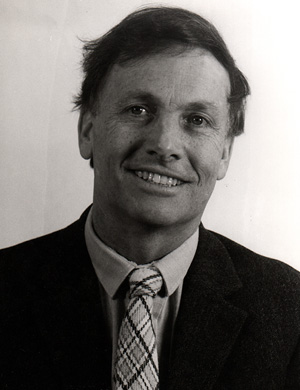
Bob Kiely, 1975
I knew that there would be challenges when I accepted the Mastership, but I was not quite prepared for the girl with the Russian Wolfhound. Sometime in my early and innocent days at Adams, I received complaints from students who heard a dog yelping for hours from a room in their entry. Then a sophomore told me that her roommate had moved a large dog and an “older man” into their suite. Not wanting to load this onto a new Senior Tutor, I called the student in to see me. She was very small and looked about twelve, but I could sense immediately that she had strong feelings. “That’s Dmitri’s Russian Wolfhound,” she proclaimed with no apology. “Who is Dmitri?” I asked gently. “He is a Russian ballet dancer.” (An unemployed one, it turned out.) When I began to explain that pets were not allowed in the House, her tone hardened. “Dmitri cannot live without his hound and I cannot live without Dmitri!” Realizing that I was in a place known for theatricality, I attempted to remain calm as I said that both Dmitri and the dog would have to go. She jumped up, stomped out of Apthorp House, and was never seen again in Adams. I think she actually left Harvard. I hope now that she is a middle-aged lady living happily somewhere – with or without Dmitri and his hound.
To be honest, I had led a fairly sheltered childhood and was not used to this kind of thing. The only dogs I knew were cocker spaniels and mutts growing up in Larchmont, where I went to public schools, and then to Amherst College, where I majored in English. Nor did wolfhounds, Russian or otherwise, feature even slightly during my stint in the Navy where I served two years in Pearl Harbor as an Ensign (went to Japan and Hong Kong and spent a lot of time on Waikiki Beach reading Joseph Conrad and Henry James) and a year aboard the aircraft carrier USS Coral Sea in the Mediterranean Fleet as a Lieutenant (jg) serving in communications and as ship’s organist. After working for six months as ad writer in NYC (about shoes, Chevrolets and pianos with nary a hound in sight), I realized more than ever that I wanted to be a professor of English. In 1957 I went to graduate school for my PhD at Harvard. That first year I was lonely and miserable, but I gradually made friends for life and in my third year I was invited by the Master of Leverett House to be a resident tutor. In those days you could not apply for a tutorship. You had to be recommended by a faculty member and chosen by the Master. I instantly liked being in a residential House, the contact with undergraduates and faculty from different fields, the combination of the academic and social. I admired the Master, John Conway: Canadian historian, veteran of World War II, with warmth, wit, rare intelligence, and genuine interest in students and tutors. We became good friends and I later escorted his Australian bride, Jill Conway (who became the first woman president of Smith), down the aisle when they were married at St Paul’s Church. I met my own wife, Jana Moravkova, a brilliant, beautiful graduate student in genetics, born in Prague, a graduate of the Sorbonne, and we were married in 1962, the year I received my doctorate.
By the age of 35 I had tenure, we were living in Newton (still hound free) where my wife was teaching biology at Newton College, and we were raising three children when Derek Bok became President of Harvard and asked me to be the first Associate Dean of Undergraduate Studies. The late ‘60’s were a tough time at American universities with demonstrations, sit-ins and constant tension between faculty and students. Although Harvard had its problems, I could see that the Houses were a huge factor in providing forums for debate and (most of the time) keeping things from boiling over. When President Bok asked me to become Master of Adams House, I knew that I wanted to try it partly because I missed the smaller community of Amherst and I had seen what a positive influence Master Conway had had. Our youngest daughter Christina ‘91 was only three, but she and her eight year old brother Jan and ten year old sister Anne and my wife were game. We agreed to accept a five year term and then reconsider.
Voted one of the “one of the sexiest professors at Harvard” by Boston Magazine in 1979, Bob was described as “the epitome of Harvard Professor – wool ties, tweed blazers, and hiking boots.”
“Mostly women take his class,” the magazine oozed: “They’re swooning for him.”
It was at this point that hounds, hair, hippies (and a great deal of hilarity) began to factor in my life. The first year or two at Adams were the most challenging mainly because we all had to find our way around, get to know people, learn by trial and error. A few crucial decisions helped. Reuben Brower who had been one of my professors at Amherst and was Master in the late ‘50’s advised us to sell our Newton house and find a getaway where we could escape and have privacy as a family. We took his advice, bought a charming, somewhat dilapitated 18th century farmhouse in southern New Hampshire, and have spent weekends, holidays, and summers there ever since. Even at the busiest times of the academic year, it has been our place to unwind, ski, hike, swim, relax. The other decision, inspired by Masters Conway and Brower, was to define my job as “professor in residence” rather than CEO, boss, major-general. There was no rule-book on how to be a Master. (The Harvard at that time had a much smaller bureacracy and fewer rules, fewer deans than it does now! The President chose Masters and we always had direct access to him.) I was determined to hire the very best, most talented, most colorful tutors I could find and the most mature and efficient Senior Tutor. I made sure that music, drama, literature, and art were well represented, but we also had absolutely first-rate medical, law, economics and science tutors. I wanted all of us to think of our academic, creative roles first and our administrative roles second. Rather handing down college rules and room assignments, I much preferred to talk with students about what they were thinking, reading, studying, performing. I continued to teach a full schedule of courses (seminars and large lecture courses on the modern and post-modern novel) and tutorials; I served three years as chairman of the English Department; I spent many hours every week in my Widener study, and published articles and various books, including one on Robert Louis Stevenson, one on the Romantic Novel in England, one on Virginia Woolf, James Joyce and D. H. Lawrence, and one on the post-modern novel.
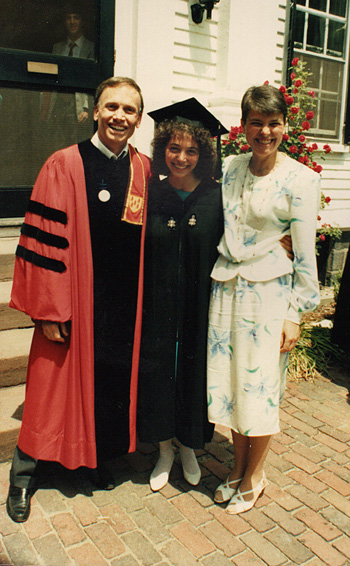
Bob and Jana Kiely with Naama Patok ’87
My wife Jana was Director of Religious Education at St Paul’s Parish so her commute across the street was as short as mine to the Yard. After a few years when she and several Masters’ wives (all the Masters were men) proposed that spouses have the option of becoming Associate or Co-Masters (with a stipend and a Harvard ID which until then they did not have), she chose Associate because her job and our children took much of her time. (Our fourth child, Maria ’99, was born in 1977 and grew up as a native Adamsian.) Our division of labor was bordered by Plympton Street. She presided over everything at Apthorp House, hiring student helpers, managing the budget, arranging the almost weekly receptions, teas, dinners. Our children adjusted quickly. There were times when they missed living in a neighborhood with other kids, but often married tutors and Senior Tutors had children they could play with. As they grew older, they loved having big brothers and sisters among the students.
As for the “other side of the street,” I was kept very busy. A particular place to meet with students was in the Dining Hall. Try to imagine Adams in 1973: the serving line was still in the main hall; the room was dark; there was smoke and a lot of hair. (Smoking did not stop ‘til the late 80’s and though big hair was a ‘70’s style, Adamsians seemed to have more of it per square foot than any other House.) And half the students were women! This may not seem a big deal now, but it had only been a few years since the Houses became “co-residential.” Because Radcliffe was considerably smaller than Harvard, in those early years of transition women students chose their Houses. Some Houses attracted small numbers, while Adams became the first to achieve a 50/50 ratio. Some alumni and faculty thought the whole idea was risky and that mayhem would result. But, as in the classroom, House life only improved. I remember a Radcliffe trustee visiting a few years later asking a table of women students how they liked “living in a man’s house.” They all looked totally blank since no one thought of it that way any longer. The Dining Hall was rarely overcrowded since there were 300, not 400, students in the House. There was little sense of rush. People seemed to be in no hurry to leave, but would sit over their coffee and cigarettes planning the next Crimson, Advocate, Lampoon, concert, or play.
Early on I was informed that Adams House had traditions and what some thought of as anti-traditions, things that Adamsians did not do, such as lock entry-doors; celebrate graduation with a ceremony (seniors filed into Apthorp study, collected their diplomas, shook hands with the Master and Senior Tutor, and went out the side door across Plympton Street for their chicken salad); or wear bathing suits in the swimming pool. When I heard that a stranger followed one of our women students into the tunnels late at night, I had the locks changed and the entry-way doors locked despite protests from a few freedom fighters. Later in the year a delegation of seniors asked if we could have a degree ceremony, not just like the other Houses, but better, and I readily agreed. Over the years, joining the Senior Tutor and tutorial staff in celebrating the graduating seniors became one of my favorite events. As to the notorious swimming pool and the lurid folklore surrounding it, I checked an old Oak Leaf recently and found the following: “Pool open from 4 pm to midnight with a lifeguard on duty. Groups of two or more from the House may obtain a key from the Super at other hours. Women’s hour: 3-4. Suits required 4-8, otherwise optional.” We often took our children and their friends to swim. I also went a few times during the “optional” period and joined a few students of undetermined sex swimming laps. I’ll never know whether they had been warned I was coming. Actually I think they didn’t notice I was there.
Among the great Adams House traditions was the concert reading of a chapter from Winnie the Pooh at the Winter Feast, then called The Christmas Dinner. Students and members of the Senior Common Room, solemn and unsmiling in formal dress, paraded into the Dining Hall, sat on stools, and gave a dramatic reading of Expotition to the North Pole or Pooh Sticks. Chief Bob Tonis, retired head of the Harvard police ALWAYS read the part of Pooh; Professor David Maybury-Lewis, British and dapper, ALWAYS read the narration in exquisite Queen’s English; and the Master ALWAYS was supposed to read the part of Christopher Robin. After a year or so of too few, too straight lines, I rebelled and assigned myself the role of Eeyore which I felt gave greater scope to my acting ability. Some House Masters considered giving up the seasonal celebration altogether for fear of offending the religious or non-religious feelings of some students or because in their Houses the meal had turned into a rowdy food-fight. I never felt that civility, tradition, and good times were mutually exclusive. The solution did not seem to me “animal house” or nothing. The kitchen staff worked their hearts out to feed us well. Should we show our thanks by throwing the food at one another? After discussions with students and tutors, we changed the name to Winter Feast and invited students from various traditions to sing, chant, light candles, or recite for the benefit of all. The evening began with a feast in the main Dining Hall for students, a formal dinner in the Library for the Senior Common Room, dessert and coffee for all in the Gold Room, entertainment in the Dining Hall, and caroling and eggnog at Apthorp House. The innovation that I was proudest of was the singing of African-American spirituals by the House Associate, the late, much loved Ruth Hamilton, a librarian at the Science Center, who had spent her earlier years as a Gospel Singer in the South. Her lovely and powerful voice, her dignified presence was a gift to us all. I rarely heard that big room fall so silent as when she sang or the applause so thunderous as when she finished. One of my regrets is that in those low-tech days we never thought to record or video-tape her.
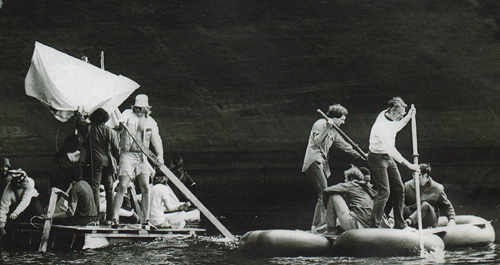
Passing under the weeks bridge in the 70s
Another House tradition, now probably gone forever, was the Adams House Raft Race on the Charles River each spring. Every House and some dorms from MIT and BU constructed rafts—floating objects of varying size and shape—that started somewhere down river and ended, if they were still afloat, at the Weld Boathouse. All had to be hand-propelled. MIT and Dunster House tended to design the most elaborate and seaworthy craft. Adamsians created the most stylish T-shirts (I still have a few faded originals), organized appearances by the Harvard Band and local models, and persuaded beer distributors to set up bleachers and provide free kegs. (Mass. drinking age was still 18.) What were the Adams rafts like? Hmmm. One or two sank in mid-race. Most started late and finished last. I still remember waking up early in the morning of the race to the sound of hammering in Randolph Court where a team, aided by my ten year old son, were patching together what looked like sticks, balloons, and empty oil cans. I think their craft started but did not complete the race. Since I awarded the prizes, beer and t-shirts, I created a prize for “worst and last” as well as for “first and best.” Afterwards we all came back to Randolph Court where the Dining Hall set up a barbecue and a student band played into the night. As years went by, the crowds of spectators grew beyond Harvard and became pretty rowdy. Townies began throwing rotten vegetables and other objects at the rafts. One student was hit by a rock and fell into the polluted Charles. Fortunately, he was pulled out and taken to Stillman for a tetanus shot, but that was the end of the affair. The Dean of Students cancelled the Raft Race ever after. Too bad. But it had become dangerous.
“French Wall ’83 and his date cut in on my wife and me. When I found myself waltzing with a tall handsome junior, I asked, “Who should lead?” I’ll never forget his answer: ‘You’re the Master!'”
During that first decade of our time at Adams, two events—both initiated by students—changed (for the better) life in the House for years to come. The first began one lunchtime when a small group of students I thought I knew well joined me. When others at the table left, they began a bit shyly to explain that they were gay and hoped to form a student organization that would be recognized by the College and could hold meetings in Adams House. When they asked me to be one of their faculty advisers, I was deeply touched by their trust. (We have to try to remember that in the Harvard of that time, homosexuality was not part of the public conversation. When mentioned, it was either on the sly or with embarrassment. I recall a dean telling me that he had heard there were gay students at Adams and wondered if I wanted him to “do something about it.” I told him that I never asked students about their sexual orientation and, in any case, I did not want anything to be “done about it.”) Over the next year or two, these students and their friends visited all the House Masters and set up tables in all of the Houses inviting anyone who wanted to sit with them. It took courage. Some Masters and students cooperated; others did not. One Master told me that “X House had no gays. It was an Adams House problem!” That spring I made a point to invite the newly formed organization to come with dates to the Waltz Evening which they did, women with women, men with men. French Wall ’83 and his date cut in on my wife and me. When I found myself waltzing with a tall handsome junior, I asked, “Who should lead?” I’ll never forget his answer: “You’re the Master!”
The second event that changed the way things were done in Adams House for years to come began in the Lower Common Room at a reception for new sophomores. A jolly personage came smiling up to me, shook my hand vigorously, introduced himself as Peter Sellars ‘80, and asked for twenty-five dollars from the Master’s Fund to clean up and paint an old basement storage room so that it could be used as a theater. At first, I thought he was kidding, but it quickly became clear to me that despite deferential giggles and guffaws, he was in earnest. So I figured twenty-five bucks, what can I lose? But little did I imagine what Adams House and the College were about to gain! Within days, the dungeon-like space was cleaned, painted, and lighted. Not very well lighted, but there were a light bulb and two small dirty windows looking out at people’s feet passing up and down Plympton Street. Soon those feet were headed to Explosives-B, the new Adams House theater, seating capacity a comfortable twenty or an uncomfortable forty sitting on mattresses left over from storage. The first production, if I remember correctly, was a Polish satire that involved an enormous hand made of plywood that kept entering menacingly from the only door. The performances, the concept (short plays, no admission charge, limited space, late starting times), and the unbounded creativity and imagination of the director and actors made the place a sensation. Everyone wanted to come! People lined up in Randolph Court hoping to squeeze in.
Theatrical talent and ideas rained down on Adams House. A new play seemed to appear every few weeks. Some were new and experimental, others old favorites. Nothing seemed too ambitious. I went to them all, but some still seem to have been impossibly terrific. Peter decided to do something Russian. Was it Boris Goudonov? Anyway, it was a mammoth Russian opera cut down to forty minutes. Peter liked moving his audiences around, so it began in Explosives–B, then, with the director leading us on like Puck, we moved to the Billiard Room where Boris or someone died on the green felt table, and then we all were taken (in a lightly falling snow) to the Lowell House courtyard where I swear he had arranged to have the Russian bells ring. Am I dreaming this? Some of the details may be wrong, but the picture is right. Other classics followed in various unlikely places: a thirty-five minute Macbeth with three actors in the tunnels; Genet’s “Balcony” utilizing the staircase of the Gold Room, and most memorable of all, Antony and Cleopatra in the Adams House pool (audience sitting around the sides, Cleopatra enthroned on a raft in the middle of the water.) They were some of the very best, most original theater I have ever seen at Harvard. Peter would sit in the Dining Hall, eyeing the crowd and then walk up to someone who had never been on stage, saying, “You would be a terrific Lady Macbeth.” Non-actors became actors; non-stages became stages.
For years after Peter graduated, variations on his ideas continued. In a House that had seemed to have no convenient theatrical space, the whole place—C-entry, the Library, the Upper Common Room, and another storage room named for Acting Masters Richard and Joanne Kronauer– seemed just perfect for Beckett, Genet, or Shakespeare. (Our youngest daughter Maria ‘99 who was born while we were at Adams House wrote and directed a play that was performed on the roof of C-entry. Audiences were provided with blankets on cool nights. Peter would have loved it.)
Contrary to popular opinion, Adams House had some fine athletes—varsity tennis, crew, basketball, soccer, and squash were well represented. The House had four of its own private squash courts. But there is no denying that the House became a haven for students who thought of it as different from mainstream Harvard. In those days students chose their Houses. And that is exactly what they did. Writers, actors, artists, and musicians found and helped to sustain their own “Left Bank.” Many dressed the part. You saw more black in Adams than anywhere at Harvard. Some outsiders found it pretentious, but I loved it mainly because I knew that beneath the stylish surface, most of these students took their art seriously. I can never forget Maggie-Meg Reed ’81 belting out show-stoppers that turned the Dining Hall into the best (only) nightclub at Harvard; or the exquisite Tamara Mitchel ’78 (who later became Law Tutor while resting her mezzo-soprano voice) and the rich-toned, warm-hearted Margery Helmold ‘83. Roy Kogan ‘81, Max Sung ‘75, and the exceptional David Braverman ’82 (who graduated first in his class and lost his life during his first year of medical school) were already accomplished pianists. We were extremely lucky in our music tutors, Robert Sirota (who composed the music for an original Adams House opera based on Isaac Bashevis Singer’s Bontshe the Silent) and his organist wife Vicki; Jim Ross ‘81, student conductor of the Bach Society; Beverly Taylor, conductor of the Radcliffe Choral Society and the first woman to conduct the Harvard Orchestra and combined Glee Clubs. Conductor and founder of the Pro Arte Orchestra, the great Reverend Larry Hill, of beloved memory, was a House Associate. For years he turned Adams into a little Vienna, bringing Pro Arte to play at our Waltz Evenings.
Two unforgettable student artists (and characters) were Romolo del Deo ’82 and Doug Fitch ‘81. At different times, both had a key to Apthorp House and used our basement as their studio; both eventually became Resident Tutors; and both went on to distinguished creative careers. Occasionally, weird odors of epoxy and paint wafted into our kitchen, but I could not say no to any of these people. I saw how hard they worked, how determined they were, how many hours way beyond class time they spent. Romolo was the right-hand man of sculptor Dmitri Hadzi (Adams Associate.) He was also a fantastic chef and now and then, he would surprise us with a fabulous Italian dinner. Doug designed the Larry Hill Memorial Bench and the biggest, best, most menacing papier-mache dragon for Chinese New Year.
It is tempting as I look back over old Facebooks to conclude with a litany of names, but the list would go on much too long. I am struck by how quickly I realized that the best pool for House tutors was recent Adams graduates. Just a few examples in addition to those previously mentioned: Jeff Melvoin ’75 (who already knew how to write), Jeff Sachs ‘76 (who got an early start giving sound economic advice), Aaron Alter ’79 (the happiest Hawaiian of Law tutors), Roz Anderson ’77 and Willis Emmons ‘81 (both of whom made Gilbert and Sullivan sparkle), Jim Barondess ’79 (who revived the Bow and Arrow Press and ran it skillfully for many years), Gino Lee ’84 (who kept the Press going), John Krasznekewicz ’79 ( a wizard Business Tutor), Bill Mayer ’78 (who kept us up on Chicago politics), and Rebecca Spang ’83 (who became Acting Senior Tutor.) Thinking of what made those years so happy, I still see the smiles of Bella and Ivone on the serving line, Manager Paul DuFour and Chef Winston. Gayle Boose, Ginnie Fletcher, and Jessie Iarrabino kept the House office running smoothly. The Senior Common Room grew and flourished. Professors Patrice Higonnet, Norm Shapiro, Richard Wilson, and Jack Womack were well established before the Kielys arrived and have been faithful associates ever since. Gifted and conscientious Senior Tutors, Larry Besserman, Peter Dale, and John Hildebidle (all mysteriously hired from the English Department) brought working wives, growing families, and a reminder of the real world to I-entry. In Apthorp House, Hilda De Courcy, hired as a housekeeper by Master Brower in the 1950’s, baked brownies for the Teas, supervised all receptions and dinners like a Major-General, and became a beloved “grandmother” to our newborn Adamsian who came home from the hospital in 1977 and was introduced at a Friday Tea.
I think I must have driven the other Masters crazy bragging about Adams House, but I couldn’t help myself. There was no doubt in my mind that Adams was more civilized and more fun than anyplace, that it was the best neighborhood with the greatest concentration of talent in Cambridge. And then in 1982-83, for something entirely new (knowing that we would return), we went on sabbatical to China….
TO BE CONTINUED…

